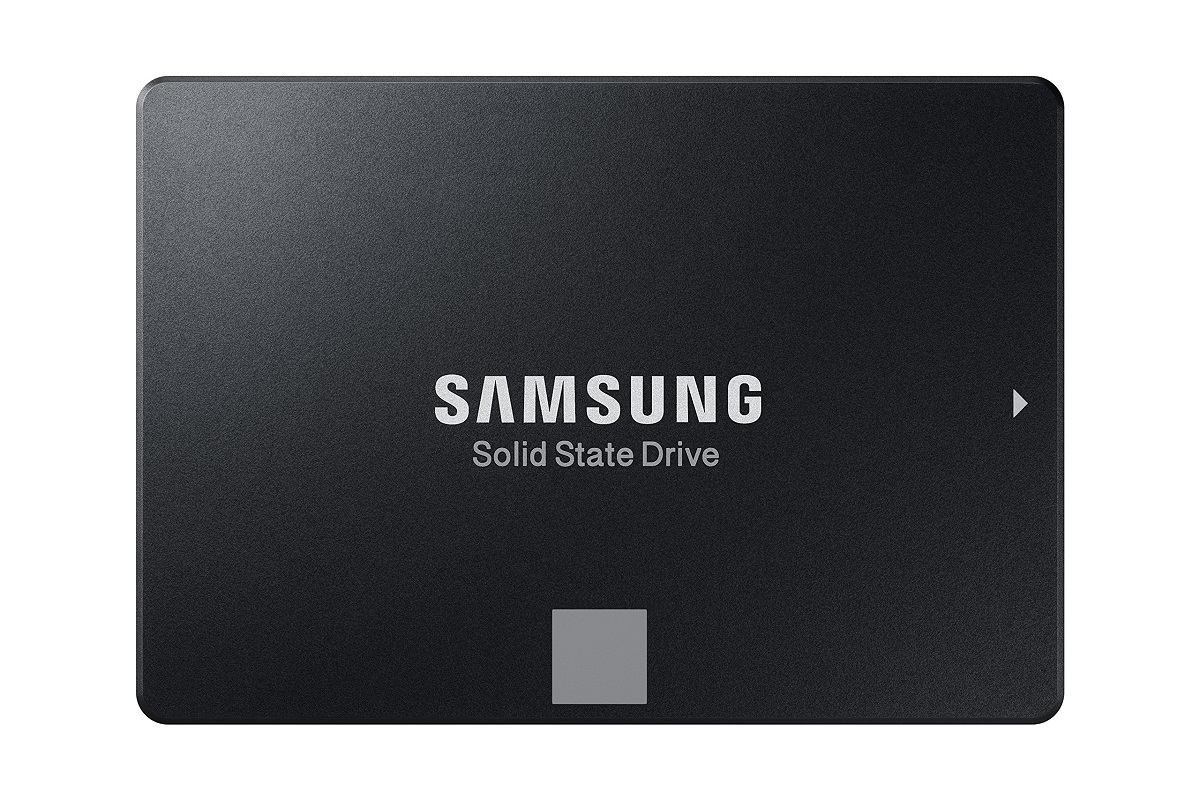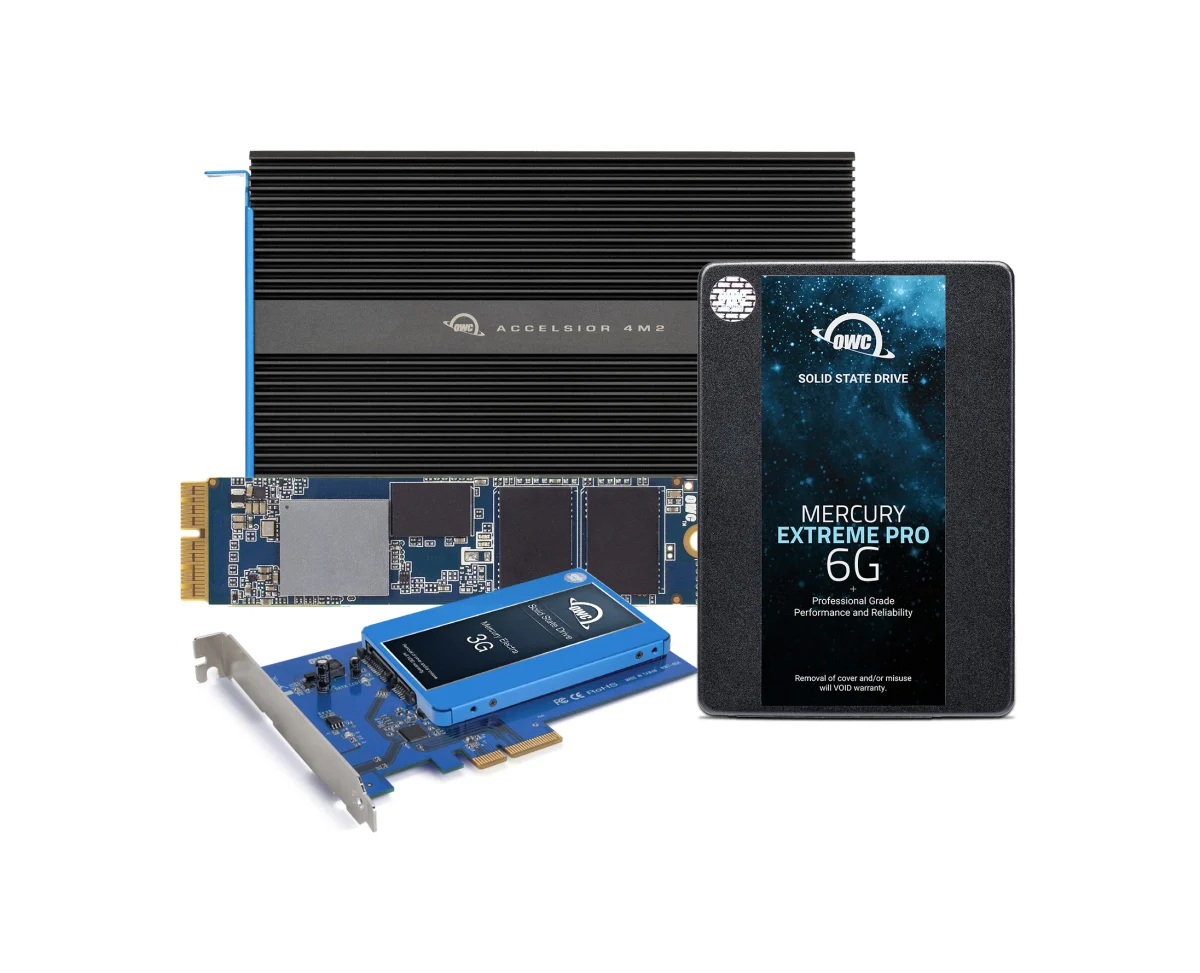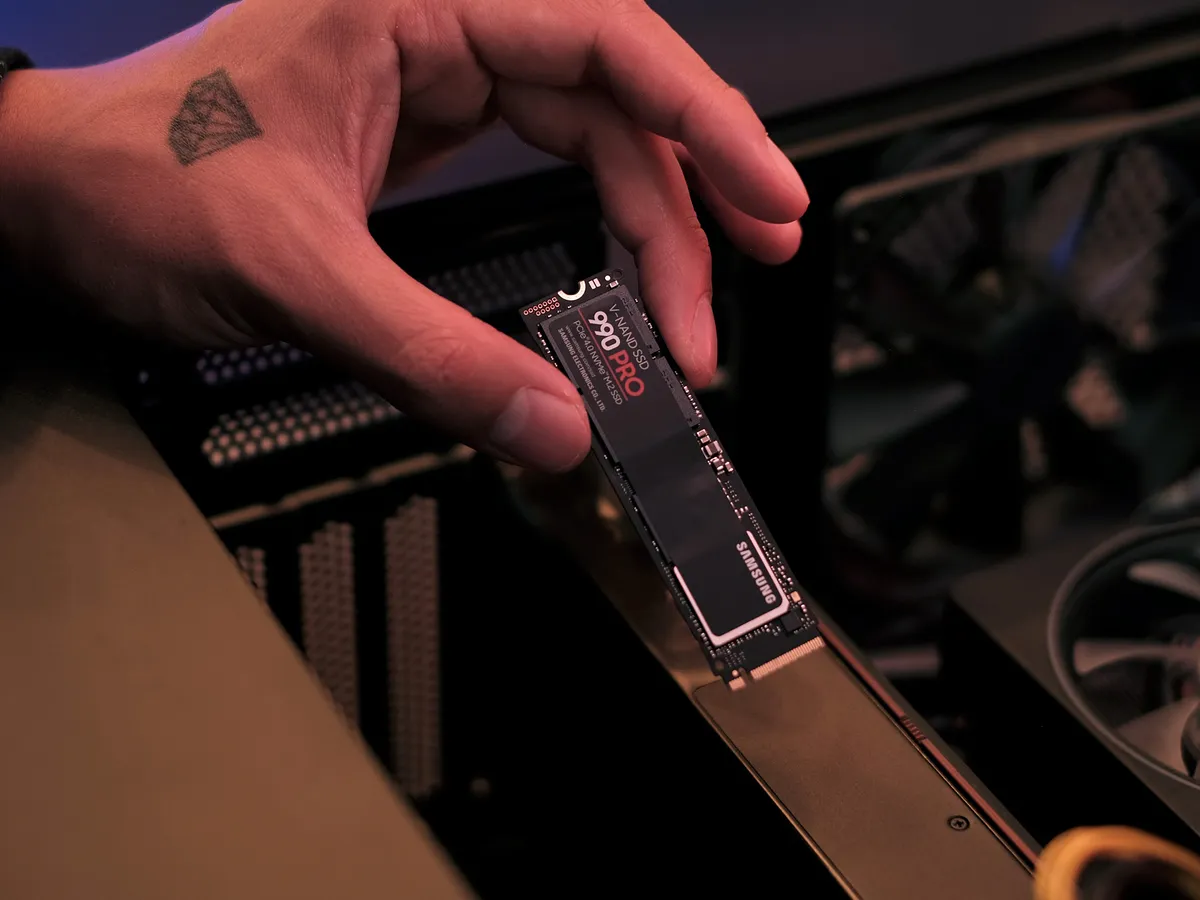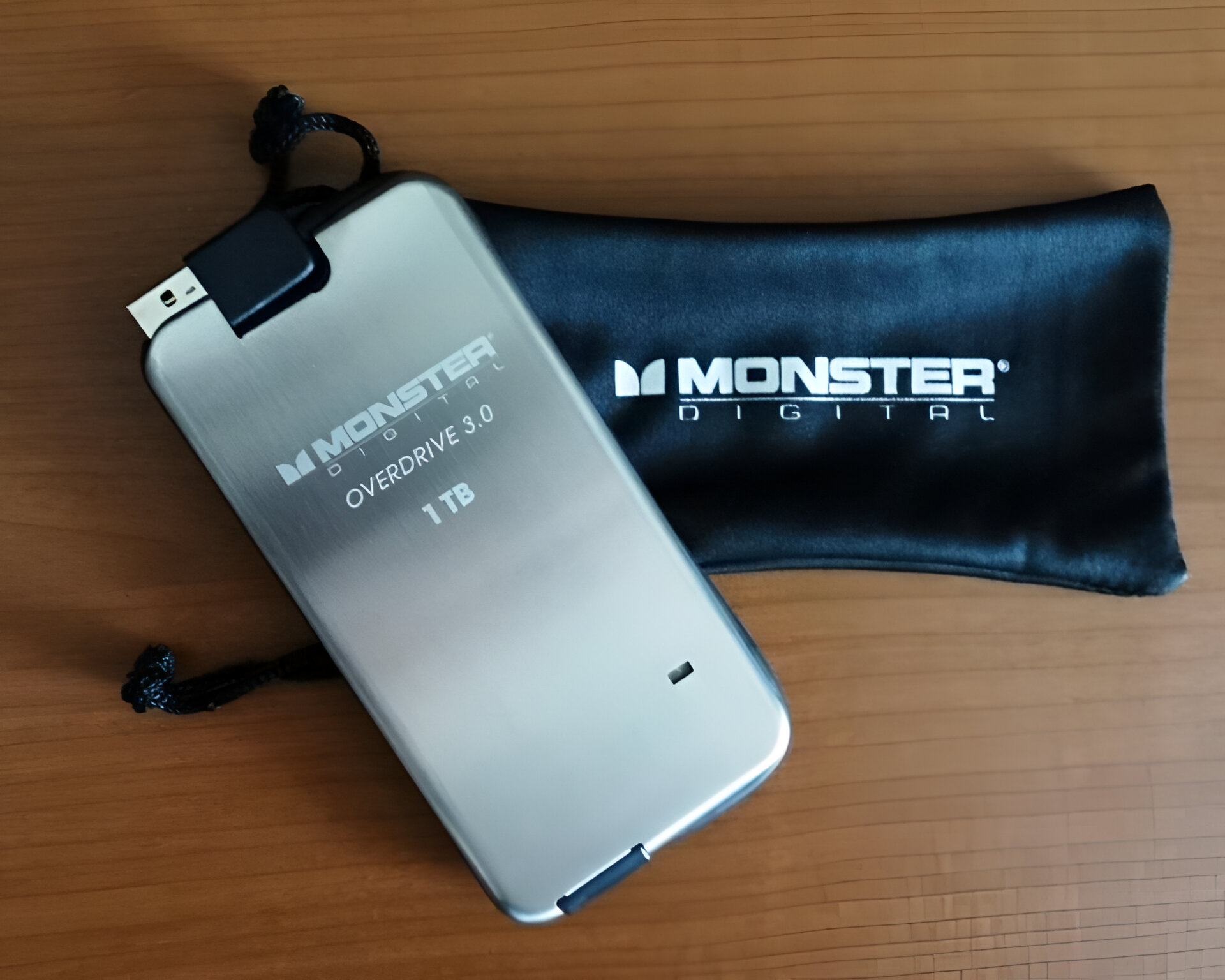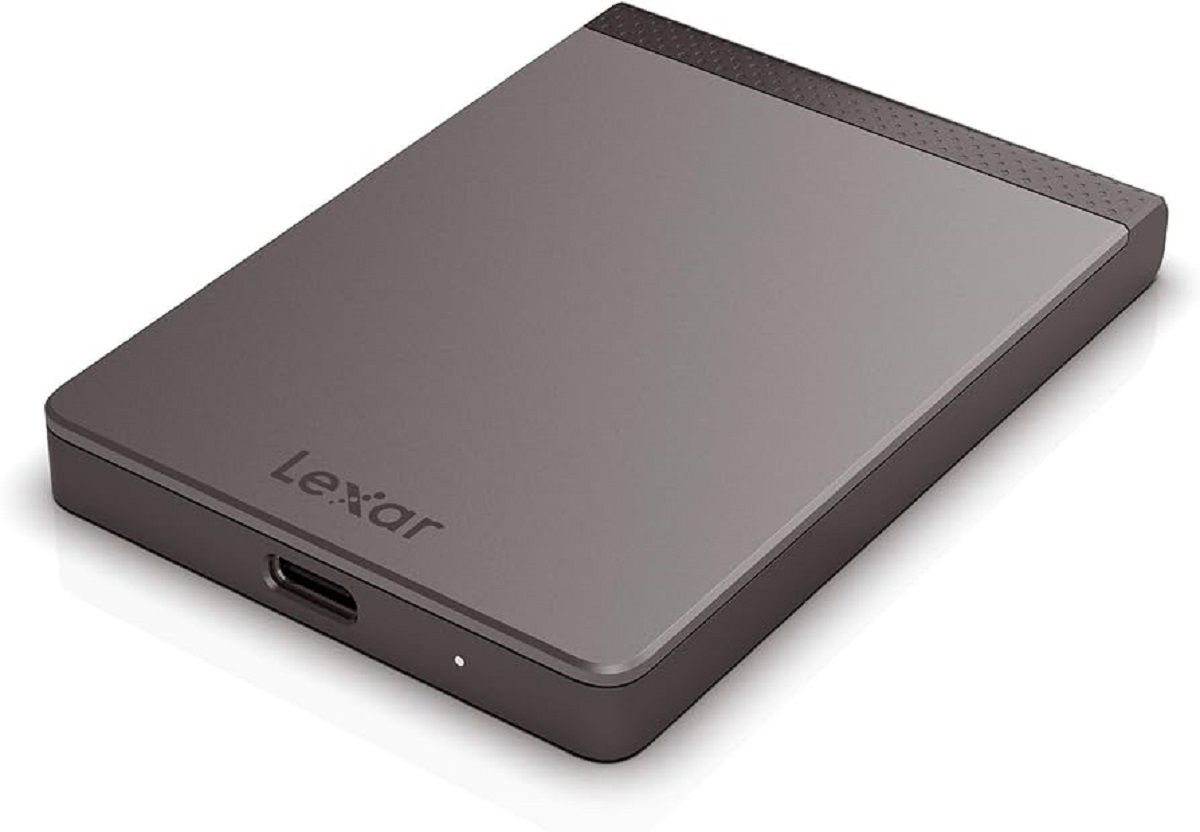Introduction
Welcome to the world of solid state drives (SSDs)! If you’re thinking about upgrading your computer’s storage for faster performance, improved reliability, and increased capacity, then you’re on the right track. In this article, we will guide you through the process of buying a solid state drive, helping you make an informed decision.
SSDs have revolutionized the storage industry by providing lightning-fast speeds and enhanced durability compared to traditional hard disk drives (HDDs). With no spinning disks or moving parts, SSDs deliver significantly faster data access times and improved system responsiveness. Whether you’re a gamer, a professional seeking faster productivity, or simply desire a seamless computing experience, an SSD can be a game-changer.
However, diving into the world of SSDs can be overwhelming, with countless options available from different brands and manufacturers. That’s where we come in. Our aim is to simplify the buying process and help you choose the right SSD for your needs, system requirements, and budget.
Throughout this article, we will explore various factors to consider when purchasing an SSD, such as performance, capacity, price, reliability, form factor, interface, compatibility, and user reviews. By understanding these key aspects, you’ll be equipped with the knowledge needed to make an informed decision and find the perfect SSD to meet your specific requirements.
So, let’s get started on your journey to finding the ideal solid state drive. Whether you’re upgrading an existing system or building a new one from scratch, we’re here to provide you with the information you need to buy an SSD that will enhance your computing experience and keep up with your demands for years to come.
Researching SSDs
Before jumping into the world of solid state drives (SSDs), it’s crucial to conduct thorough research to ensure you make an informed decision. With a wide range of options available, understanding the various aspects of SSDs will help you find the perfect fit for your needs.
Start by familiarizing yourself with the different types of SSDs on the market. The two main categories are SATA SSDs and NVMe SSDs. SATA SSDs connect to your system using the standard SATA interface, while NVMe SSDs utilize the faster NVMe (Non-Volatile Memory Express) protocol, enabling even faster read and write speeds. Determining which interface you need will depend on your system’s compatibility and performance requirements.
Next, consider your specific needs and use cases. Are you a gamer seeking faster load times and improved gaming performance? Are you a content creator who requires high-speed data transfer for video editing? Assessing your requirements will help you prioritize certain aspects of an SSD, such as capacity and speed.
Another crucial aspect to consider is the endurance and reliability of the SSD. Some SSDs are designed for heavy workloads, while others are more suitable for normal everyday use. Look into the SSD’s endurance rating, typically measured in terms of Terabytes Written (TBW), to ensure it can withstand the demands of your workload.
When researching SSDs, be sure to explore user reviews and expert opinions. Read up on individual experiences to get a realistic understanding of the SSD’s performance, reliability, and longevity. Expert reviews and comparisons can also provide valuable insights into how different SSDs stack up against one another.
Lastly, don’t forget to compare brands and manufacturers. Some renowned SSD manufacturers, such as Samsung, Crucial, Western Digital, and Kingston, have established themselves as reliable and reputable brands in the industry. However, it’s always worth checking out lesser-known brands as they may offer competitive prices and solid performance.
By thoroughly researching SSDs, you’ll gain a comprehensive understanding of the available options and be better equipped to make a smart purchasing decision. Whether it’s evaluating the different types of SSDs, assessing your specific needs, considering endurance and reliability, reading user reviews, or comparing brands, taking the time to research will ensure you find an SSD that meets your requirements and delivers a smooth and efficient computing experience.
Determining Your Needs
When it comes to buying a solid state drive (SSD), it’s crucial to determine your specific needs before diving into the sea of options available. By understanding your requirements, you can choose an SSD that best aligns with your usage patterns, budget, and future plans.
One of the primary considerations is the intended use of the SSD. Are you primarily using your computer for gaming, work, or multimedia tasks? If gaming is your focus, you’ll want an SSD with fast read speeds to reduce load times and improve in-game performance. For professional work, such as graphic design, video editing, or data analysis, an SSD with both fast read and write speeds will ensure quick access and manipulation of large files.
Capacity is another essential factor to consider. Determine the amount of storage space you require, keeping in mind that SSDs often come in various capacities, ranging from 128GB to several terabytes. Assess your data storage needs and consider the size of your existing files as well as any future expansion plans. Remember, it’s always better to have more storage space than not enough.
Budget is another important consideration. Set a realistic budget that aligns with your requirements and explore SSD options within that price range. While larger capacity and faster speeds often come at a higher cost, it’s important to find a balance between performance and affordability. Prioritize your needs and invest in the features that will have the most impact on your usage.
Future-proofing your system is also worth considering. If you’re planning to upgrade other components or expand your storage needs in the near future, it may be wise to choose an SSD with higher capacity than your current requirements. This will ensure that you have sufficient space as your data and system demands grow over time.
Lastly, consider the compatibility of the SSD with your system. Check the interface and form factor requirements of your computer or laptop to ensure the SSD is compatible. Most modern systems support both SATA and NVMe interfaces, but it’s always best to double-check.
By taking the time to determine your needs, considering factors such as usage patterns, required capacity, budget, future plans, and system compatibility, you’ll be better equipped to select an SSD that meets your specific requirements. Remember, finding the right SSD that aligns with your needs will not only provide a significant upgrade in overall system performance but also ensure a smooth and seamless computing experience for years to come.
Understanding the Different Components of an SSD
When buying a solid state drive (SSD), it’s important to have a basic understanding of the different components that make up this advanced storage technology. Knowing how these components work together will enable you to make an informed decision when selecting the right SSD for your needs.
1. Flash Memory: The heart of an SSD is the flash memory, which stores your data. There are two types of flash memory used in SSDs: SLC (Single-Level Cell) and MLC (Multi-Level Cell). SLC offers faster performance and longer endurance, while MLC provides higher storage density at a more affordable price point.
2. Controller: The controller acts as the brain of the SSD, managing data transfers, error correction, and wear leveling. A good SSD controller optimizes performance, improves endurance, and ensures the reliability of data storage.
3. DRAM Cache: Many SSDs come equipped with a small amount of DRAM (Dynamic Random Access Memory) cache. The cache helps improve read and write speeds by temporarily storing frequently accessed data, reducing the time needed to retrieve information from the flash memory.
4. Interface: SSDs connect to your computer via an interface like SATA (Serial ATA) or NVMe (Non-Volatile Memory Express). SATA is the most common interface and offers decent performance for everyday computing tasks. NVMe, on the other hand, is designed for high-speed data transfer and offers significantly faster performance, especially when coupled with the PCIe (Peripheral Component Interconnect Express) interface.
5. Form Factor: SSDs are available in various form factors, including traditional 2.5-inch drives, M.2 drives, and PCIe expansion cards. The form factor you choose should be compatible with your system and its available slots.
Understanding these components will help you assess the performance, durability, and compatibility of different SSD models. Consider your specific needs, such as speed requirements, storage capacity, and budget, to choose the right combination of components that meets your demands.
Remember, a well-designed SSD with high-quality components will deliver faster data access, improved system responsiveness, and enhanced durability compared to traditional hard disk drives (HDDs). By understanding the different components and their impact on performance, you can make an educated decision and invest in an SSD that will enhance your overall computing experience.
Evaluating Performance
When purchasing a solid state drive (SSD), evaluating its performance is crucial to ensure that it meets your needs and expectations. Performance factors such as speed, latency, and IOPS (Input/Output Operations Per Second) can significantly impact your overall computing experience. Understanding these metrics will help you make an informed decision and choose an SSD that delivers the desired level of performance.
The speed of an SSD is typically measured in terms of read and write speeds, which indicate how quickly data can be accessed and stored. Faster speeds result in reduced load times, improved file transfer rates, and enhanced system responsiveness. SSDs with higher read and write speeds are ideal for tasks that involve frequent file access and data manipulation, such as gaming, video editing, and content creation.
Another performance metric to consider is latency, which refers to the amount of time it takes for the system to respond to a request. SSDs generally have lower latency compared to traditional hard disk drives (HDDs), resulting in faster data access. Lower latency contributes to smoother multitasking, faster application launches, and quicker system boot times.
IOPS, or Input/Output Operations Per Second, is a measure of how many read and write operations an SSD can handle within a given time frame. Higher IOPS generally indicate better performance, particularly in scenarios that involve random access to small files, such as running multiple virtual machines or database operations. However, it’s important to note that IOPS alone may not accurately represent real-world performance, so it’s best to consider a combination of factors when evaluating an SSD’s overall performance.
When comparing SSDs, it’s essential to look beyond the manufacturer’s claimed performance figures and consider independent reviews and benchmarks. Expert reviews and user feedback provide valuable insights into real-world performance and can help validate the claimed specifications of an SSD. Look for benchmarks that mirror your specific use cases and compare the performance of different SSD models under similar conditions. Remember that choosing the right SSD with optimal performance is crucial for maximizing the benefits of your investment.
Ultimately, evaluating the performance of an SSD is a balancing act between speed, latency, and IOPS, which vary based on your specific usage patterns and requirements. Assess your needs, consider the tasks you’ll be performing, and prioritize the performance factors that are most important for your use case. By doing so, you can choose an SSD that offers the right balance of speed, responsiveness, and overall performance to enhance your computing experience.
Capacity and Price Considerations
When it comes to buying a solid state drive (SSD), capacity and price are two important factors to consider. Determining the appropriate capacity and finding the right balance between storage space and budget will ensure that you get the most out of your SSD purchase.
The capacity of an SSD refers to the amount of data it can store. SSDs come in a variety of capacities, ranging from 128GB to several terabytes. The capacity you choose should be based on your specific needs and usage patterns. Consider the type of files you’ll be storing, such as documents, photos, videos, games, or applications. Assess the size of your existing data and estimate any future storage requirements to determine the appropriate capacity.
It’s important to remember that the usable capacity of an SSD is slightly lower than the advertised capacity due to formatting and system files. Manufacturers also reserve a portion of the storage space for overprovisioning, which helps improve the SSD’s performance and longevity. Take these factors into account when selecting the capacity to ensure sufficient storage for your needs.
Price is another crucial consideration when buying an SSD. While SSD prices have significantly decreased over the years, they still tend to be more expensive compared to traditional hard disk drives (HDDs). SSD pricing is largely influenced by its capacity, performance, and brand reputation. Generally, higher-capacity SSDs with faster speeds and superior endurance come at a higher price point.
Consider your budget and prioritize your needs. If you require larger storage capacity, you may need to spend more. However, if your requirements are modest, you can find affordable SSD options with ample capacity to meet your needs without breaking the bank. Keep an eye on deals, discounts, and promotional offers to potentially snag a better price on an SSD that meets your requirements.
It’s worth noting that investing in a reliable and reputable brand can have a positive impact on the overall performance and longevity of your SSD. Well-known brands often offer reliable products backed by warranties and excellent customer support. However, if budget is a concern, consider exploring lesser-known brands that may offer competitive prices without compromising on performance and reliability.
By considering both capacity and price, you can find the right balance between storage space and affordability when purchasing an SSD. Evaluate your specific needs, estimate your storage requirements, set a budget, and weigh the pricing options available from various brands. With careful consideration, you’ll be able to choose an SSD that offers adequate storage capacity at a price point that fits your budget.
Reliability and Endurance
When considering a solid state drive (SSD) for your storage needs, it’s important to assess the reliability and endurance of the drive. By understanding these factors, you can choose an SSD that will provide reliable and consistent performance throughout its lifespan.
Reliability is a key consideration when purchasing an SSD. Unlike traditional hard disk drives (HDDs) that contain moving parts, SSDs have no mechanical components, making them less prone to mechanical failure. However, it’s still important to ensure that the SSD you choose is built with high-quality components and designed for durability.
One aspect to consider is the reliability track record of the manufacturer. Well-established and reputable brands often have a history of producing reliable SSDs. Research customer reviews, expert opinions, and check for any known issues or patterns of failure associated with the SSD model you’re interested in.
Endurance refers to the lifespan and durability of an SSD, particularly in terms of the number of read and write cycles the drive can endure. SSDs have a limited number of program-erase cycles, after which the cells may wear out, leading to degraded performance or failure. Manufacturers provide an endurance rating for their SSDs, typically measured in terms of Terabytes Written (TBW).
When evaluating endurance, consider your usage patterns and workload requirements. If you anticipate heavy use, such as running resource-intensive software or frequently writing and deleting large files, it’s advisable to choose an SSD with a higher endurance rating. On the other hand, if your usage is relatively light, a lower-rated SSD may still provide ample durability for your needs.
It’s also worth noting that some SSDs employ technologies and features like wear leveling, overprovisioning, and error correction codes (ECC) to extend the lifespan and enhance the endurance of the drive. These features help distribute data evenly across the cells, reducing wear on specific areas of the SSD and maximizing the overall lifespan of the drive.
Additionally, many SSDs come with warranties that vary depending on the manufacturer and model. Warranty terms typically cover a specified period and assure protection against defects and failures. Consider the warranty length and the reliability of the manufacturer’s customer support when making your purchasing decision.
By evaluating both the reliability and endurance of an SSD, you can make an informed decision and choose a drive that will provide consistent performance and reliability throughout its lifespan. Thoroughly research the manufacturer’s reputation, read customer reviews, and consider the endurance rating and warranty terms to ensure that the SSD you select meets your requirements and provides a reliable storage solution for your data.
Considering Form Factor and Interface
When buying a solid state drive (SSD), considering the form factor and interface is essential to ensure compatibility with your system and maximize the performance benefits of the SSD. Understanding these factors will help you choose the right SSD that fits seamlessly into your computer or laptop.
The form factor of an SSD refers to its physical size and shape. SSDs are available in various form factors, with the most common being 2.5-inch drives and M.2 drives. The 2.5-inch form factor is similar to a traditional laptop hard drive and is commonly used in desktop computers and laptops with traditional drive bays. On the other hand, M.2 drives are smaller and more compact, designed for ultrabooks, thin laptops, and mini-PCs with limited space.
It’s crucial to check the available slots and connectors on your computer’s motherboard to ensure compatibility with the chosen form factor. Measure the available space inside your system and check the specifications or user manual to determine which form factor is compatible with your system.
The interface is another important consideration when it comes to SSDs. The interface determines how the SSD connects to your system and influences the data transfer speeds. The two most common interfaces for SSDs are SATA (Serial ATA) and NVMe (Non-Volatile Memory Express).
SATA is the standard interface used by most SSDs and is compatible with a wide range of systems. It offers decent data transfer speeds, making it suitable for everyday computing tasks. SATA III, the latest iteration, offers speeds of up to 6 gigabits per second.
NVMe, on the other hand, is a newer interface designed specifically for SSDs, offering significantly faster data transfer speeds compared to SATA. NVMe SSDs utilize the PCIe (Peripheral Component Interconnect Express) interface, providing lightning-fast speeds that can greatly enhance the performance of tasks that involve large file transfers, such as gaming, video editing, and data analysis.
When evaluating the interface, check your system’s compatibility and determine whether it supports SATA or NVMe. Consult your motherboard’s specifications or user manual to ensure compatibility, especially if you’re considering an NVMe SSD, as some older systems may not have the necessary M.2 slots or the PCIe support required for NVMe drives.
By considering the form factor and interface, you can ensure that the SSD you choose is compatible with your system’s physical specifications and interface requirements. Whether you opt for a 2.5-inch drive or an M.2 drive, and whether you select a SATA or NVMe interface, making sure that the SSD aligns with your system’s capabilities will allow you to seamlessly integrate the SSD into your system and enjoy the maximum performance benefits it has to offer.
Compatibility with Your System
When it comes to purchasing a solid state drive (SSD), ensuring compatibility with your system is crucial. By considering factors such as connector types, power requirements, and software support, you can choose an SSD that seamlessly integrates with your system and delivers optimal performance.
One of the first things to consider is the connector type on your computer’s motherboard or on the expansion cards. The most common connector types for SSDs are SATA (Serial ATA) and M.2 (formerly known as NGFF). SATA SSDs typically use a standard SATA data and power cable, making them compatible with most desktop computers and laptops that have SATA ports. M.2 SSDs, on the other hand, utilize a small, thin form factor and connect directly to the M.2 slot on the motherboard, usually using a PCIe or SATA interface.
When selecting an SSD, check your system’s specifications or consult the user manual to verify the compatibility of the connector type. This will ensure a hassle-free installation process and avoid any compatibility issues.
Power requirements are another consideration for SSD compatibility. Most SSDs operate on low power and can be powered by the standard connectors that come with your computer’s power supply. However, it’s important to ensure that your power supply has sufficient connectors and power capacity to support the addition of an SSD.
Another aspect of compatibility to consider is software support. This mainly applies to the operating system you’re using. SSDs are compatible with various operating systems, including Windows, macOS, and Linux. However, it’s recommended to check the manufacturer’s website or specifications to verify that the SSD you’re interested in is officially supported by your operating system. Additionally, make sure you have the latest firmware and drivers for your SSD to ensure optimal performance and compatibility.
If you’re upgrading an existing system, it’s also worth considering the compatibility of your current components with the SSD. For example, if you have an older motherboard that doesn’t support the latest SATA or M.2 standards, you may need to consider an adapter or upgrade your motherboard to ensure compatibility.
By thoroughly assessing the compatibility of an SSD with your system, including connector types, power requirements, software support, and any necessary upgrades or adapters, you can make an informed decision and choose an SSD that seamlessly integrates with your system. This will ensure optimal performance, reliability, and a smooth transition to your new SSD storage solution.
Checking User Reviews and Expert Opinions
When it comes to buying a solid state drive (SSD), it’s important to gather insights from real users and experts to make an informed decision. By checking user reviews and expert opinions, you can gain valuable information about the performance, reliability, and overall quality of different SSD models.
User reviews provide firsthand experiences from individuals who have already purchased and used the SSD you’re considering. Reading a variety of user reviews can give you a sense of the pros and cons of a particular model, highlighting its strengths and weaknesses. Look for feedback on factors such as performance, durability, compatibility, and customer support. Be sure to consider both positive and negative reviews to get a balanced perspective and a realistic understanding of the SSD’s performance.
Expert opinions and reviews can also provide valuable insights into the technical aspects and overall performance of SSDs. Technology websites, hardware reviewers, and tech enthusiasts often conduct comprehensive tests and benchmarks to evaluate the performance, speed, and endurance of different SSD models.
Reading expert reviews can help you understand the specific strengths and weaknesses of an SSD, as well as how it compares to other models in terms of performance, value for money, and reliability. Experts can offer deeper technical insights, highlight any potential issues or limitations, and compare features and specifications that may not be immediately apparent from a product listing.
When looking for expert opinions, reputable technology websites and technology-focused forums can be excellent resources. Look for reviews from trusted sources that have a track record of providing fair, unbiased, and well-informed assessments of SSDs and other hardware components.
By considering both user reviews and expert opinions, you can gain a comprehensive understanding of the SSDs you’re considering and make a more informed decision based on a range of experiences and perspectives. Remember to weigh the opinions and experiences against your own needs and priorities to find an SSD that aligns with your specific requirements.
Keep in mind that while user reviews and expert opinions can offer valuable insights, personal experiences and requirements may vary. What works well for one person may not necessarily be the best fit for another. Therefore, it’s important to view reviews as a guide rather than an absolute verdict and consider your own needs and preferences as the ultimate deciding factors.
Comparing Brands and Manufacturers
When choosing a solid state drive (SSD), considering the reputation and reliability of different brands and manufacturers is a critical aspect of the decision-making process. Each brand offers its own unique features, build quality, and customer support, which can greatly influence your overall satisfaction with the SSD. By comparing brands and manufacturers, you can make an informed decision and choose an SSD that meets your expectations and offers a reliable storage solution.
One important factor to consider is the brand’s track record in the SSD market. Reputable brands often have a long history of producing reliable and high-quality storage solutions. They have a proven track record of delivering SSDs that consistently perform well in terms of speed, endurance, and reliability. Look for brands that have established themselves as leaders in the SSD industry and have received positive feedback from users and experts alike.
Consider the range of SSD models available from different brands. Some brands offer a wide selection of drives that cater to various price points, allowing you to find an SSD that fits your budget without sacrificing quality. Pay attention to the performance specifications, such as read and write speeds, endurance ratings, and warranty coverage. Compare these features across brands to get a sense of which ones align with your needs.
Customer support and warranty coverage are also crucial factors to consider when comparing brands. Some brands offer better warranty coverage and customer support than others, which can be invaluable in case you encounter any issues or need assistance with your SSD. Look for brands that have a reputation for prompt and helpful customer support, as this can greatly enhance your overall experience and provide peace of mind.
Reading customer reviews and expert opinions can provide valuable insights into the performance and reliability of different brand offerings. Compare the experiences and feedback of users who have used SSDs from different brands to get a sense of their overall satisfaction and any recurring issues. Similarly, expert reviews and comparisons can shed light on the strengths and weaknesses of different models and brands.
In addition to considering renowned brands, it’s also worth exploring lesser-known brands that may offer competitive prices and solid performance. While these brands may not have the same established reputation as the more well-known names, they can still provide excellent value and performance. Be sure to read user reviews, delve into their warranty policies, and check for any red flags before making a decision.
By comparing brands and manufacturers, considering their reputation, range of models, customer support, warranty coverage, and the experiences of users and experts, you can make a well-informed decision and choose an SSD that meets your requirements in terms of reliability, performance, and overall satisfaction.
Making the Purchase Decision
After researching, evaluating, and comparing various aspects of solid state drives (SSDs), it’s time to make the final purchase decision. Consider the following factors to ensure you choose the best SSD that meets your specific needs and requirements.
First and foremost, take into account your budget. Set a realistic budget range and narrow down your options accordingly. While SSD prices have become more affordable over time, higher capacities and faster speeds generally come at a higher cost. Find the balance between performance and affordability that aligns with your budget constraints.
Next, carefully assess the speed and performance requirements for your intended use. If you’re a gamer or work with multimedia applications, prioritize an SSD with higher read and write speeds for faster data access. On the other hand, if you need to handle large amounts of data, focus on IOPS performance, especially if you deal with random read and write operations.
Consider the capacity that will best suit your needs. Evaluate the type of files you handle and estimate your storage requirements both currently and in the future. Strike a balance between having enough space to accommodate your files and avoiding overpaying for excessive storage capacity that you won’t fully utilize.
Reliability and endurance should be high on your checklist. Look for SSDs with a proven track record of durability and reliability, backed by positive user reviews and expert opinions. A higher endurance rating and optimistic Mean Time Between Failures (MTBF) indicate a longer lifespan and greater reliability for your data.
Take into account the form factor and interface compatibility with your system. Check whether your computer supports a 2.5-inch drive, M.2, or any other specific form factor. Verify the SATA or NVMe compatibility, PCIe slots availability, and any possible adapter requirements to guarantee a seamless installation process.
Lastly, consider the reputation and customer support of the brand and manufacturer. Opt for well-established brands known for producing reliable SSDs and providing excellent customer service. Read customer reviews to gain insight into their support responsiveness and satisfaction levels. A reputable manufacturer that offers a solid warranty can provide peace of mind and assistance in case of any issues.
By carefully considering these factors, you can make an informed purchase decision and choose the SSD that best fulfills your needs. Remember, an SSD is a long-term investment, so it’s important to select a reliable and well-suited option that will enhance your computer’s performance and storage capabilities for years to come.
Conclusion
Choosing the right solid state drive (SSD) is essential for improving the performance, reliability, and storage capacity of your computer system. Throughout this article, we have explored the key factors to consider when buying an SSD, including researching different models, determining your needs, understanding the components, evaluating performance, considering capacity and price, assessing reliability and endurance, checking compatibility, reviewing user feedback, and comparing brands.
By conducting thorough research, understanding your specific requirements, and carefully comparing different options, you can make an informed purchase decision. Consider the aspects that hold the most importance for your needs, such as speed, capacity, price, reliability, and compatibility. By prioritizing these factors, you can ensure that the SSD you choose will provide the desired performance and seamless integration with your system.
Remember to check user reviews and expert opinions to gain insights from real-world experiences and technical assessments. These valuable perspectives can help validate the claims made by manufacturers and provide a realistic understanding of each SSD’s performance, durability, and overall quality.
Ultimately, the purchase decision rests on finding the right balance between performance, affordability, and compatibility. By selecting a reputable brand, considering your specific needs, and evaluating user and expert feedback, you’ll be well-prepared to choose an SSD that will enhance your computing experience and provide reliable and efficient storage for your data.
Upgrade your storage to the lightning-fast speeds of an SSD and revolutionize your computing experience. Embrace the power and performance that an SSD brings, and enjoy faster file transfers, quicker boot times, improved application responsiveness, and enhanced reliability.
Take the time to evaluate your options, choose wisely, and embark on a journey where your computer system performs at its peak. The right SSD can open doors to new possibilities and ensure that your system is ready to tackle whatever tasks and challenges come your way.









